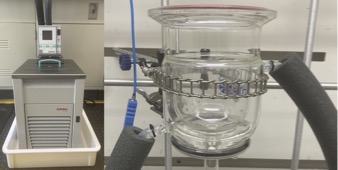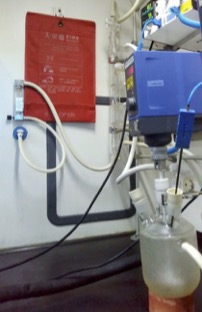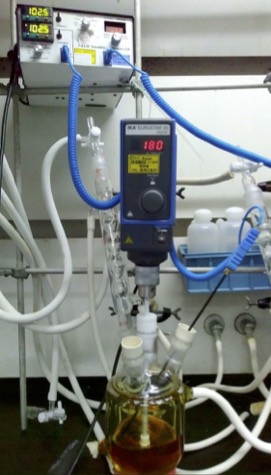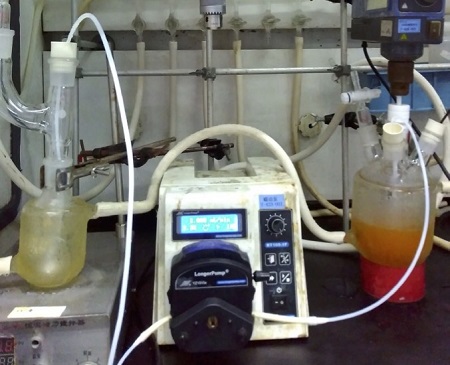Checked by Vasudevan Natarajan, Nathaniel D. Kaetzel, Rohit Mahar, Gopal Sirasani, and Chris Senanayake
1. Procedure (Note 1)
A.
9-Benzyl-9-azabicyclo[3.3.1]nonan-3-one (3)2b (
Note 1) A 500 mL six-necked jacketed, round-bottomed flask is equipped with a mechanical stirrer (IKA:180 rpm), a PTFE-coated temperature probe, and a 250 mL addition funnel (
Note 2). Water (50 g) and
benzylamine (12.9 mL, 13.2 g, 0.123 mol, 0.9 equiv) are added (
Note 3 and
Note 4). The reactor jacket is cooled by a recirculating chiller to 0-10 °C (Figure 1) and then 18%
sulfuric acid (43.2 mL, 0.089 mol, 0.65 equiv made from 98%
sulfuric acid) is added over 1 h while maintaining the reaction mixture at 4-8 °C (
Note 5). The reaction flask is protected from light with aluminum foil as a general precaution.
Glutaraldehyde (50%) (
2) (25.8 mL, 0.137 mol, 1.0 equiv) (
Note 6) is added followed by
acetone dicarboxylic acid (
1, 20 g, 0.137 mol, 1.0 equiv) (Notes
7 and
8) while maintaining the reaction mixture at <5 °C to give a light-yellow solution. At this time 9%
sodium acetate (47.8 mL, 0.055 mol, 0.4 equiv) solution is added over 1.5 h (Figure 2) (
Note 9). The reaction mixture is aged at 5 °C for 20 h and then at 25 °C for 20 h. Slow gas evolution (CO
2) is observed during the reaction (
Note 10). A sample analyzed by HPLC indicates complete consumption of
acetone dicarboxylic acid and less than 10:90 ratio of
benzylamine to product (
Note 11). Additional 18%
sulfuric acid (approximately 10 mL) is added at 20-30
oC to adjust the solution's pH to 2. The solution is transferred to a 0.5 L separation funnel and extracted with
MTBE (3 x 80 mL). The organic layers are discarded. The aqueous layer (Figure 3) is charged into a 2 L round-bottomed flask and mixed with
heptane (500 mL). Silica gel (20 g) (
Note 12) is added to the aqueous layer followed by aqueous 20%
Na2CO3 (80 mL) to adjust the pH to 8 (Figure 4) (
Note 13). The batch is filtered, and the filter cake washed with
heptane (320 mL) (
Note 14). The layers of the combined filtrate are separated (Figure 5), and the organic layer is dried with
Na2SO4 (100 g) (
Note 15). After removal of the drying agent by filtration, the solution is concentrated using a rotovap in a 1 L round-bottomed flask (bath temperature: 40 °C, vacuum: 75 mmHg). The residue is diluted with
methanol (100 mL) and concentrated by rotary evaporation again. The residue is diluted with
methanol to give a solution of
3 (93.8 g of solution) which contains 17.9 g (57%) of compound
3, as determined by quantitative
1H NMR assay. The purity of compound
3 is determined by HPLC and qNMR analysis (Notes
11 and
16). The crude product solution is used in the next step directly.

Figure 1. Step A recirculating chiller assembly (Photos provided by checkers)
Figure 2. Step A reaction assembly (Photos provided by submitters)
Figure 3. The aqueous layer after reaction (Photo provided by submitters)
Figure 4. After addition of silica gel (Photo provided by submitters)
Figure 5. Separation after filtering (Photo provided by submitters)
B.
9-Benzyl-9-azabicyclo[3.3.1]nonan-3-ol (4).2b A 500 mL three-necked round-bottomed flask is equipped with a mechanical stirrer (IKA:180 rpm), PTFE-coated temperature probe and a nitrogen line fitted to a glass bubbler. The one remaining neck is fitted loosely with a septum and is opened for addition of reagents (Figure 6) (
Note 17). A solution of
3 (20.0 g in 190 g
methanol, 0.087 mol, 1.0 equiv) is added and the reaction mixture is cooled to 0-10 °C using an ice bath.
Sodium borohydride (6.6 g, 0.174 mol, 2.0 equiv) is charged in portions over 0.5 h while maintaining the batch temperature at 0-5 °C (
Note 18). The batch is stirred at 25 °C for 0.5 h until HPLC analysis indicates completion of reaction (
Note 19). The batch is then cooled to 5 °C and quenched by slow addition of 10%
hydrochloric acid (40 mL) to adjust the batch pH to 5-6. The flask is fitted with a distillation head assembly and is heated under vacuum to concentrate the solution (Figure 7) (bath temperature: 35 °C, vacuum: 75 mmHg) to about 50 mL, at which point the solution is cooled to 5 °C and mixed with
MTBE (160 mL) (
Note 21). At this time 20%
NaOH solution (25 mL) is added at 5 °C to adjust the pH to 11-12 (
Note 22). The two layers are separated, and the aqueous layer extracted with
MTBE (160 mL). The combined organic layer is washed with 4% aqueous
NaHCO3 solution (80 mL) and concentrated under reduced pressure (bath temperature: 35 °C, pressure: 75 mmHg) to remove all solvents (
Note 23). Crude compound
4 is obtained in 19.2 g as a light-yellow solid (Figure 8) (95.5% by HPLC analysis, 93.0% by quantitative
1H NMR assay) containing 17.9 g product (89% yield), which is used directly in the next step (
Note 24).

Figure 6. Step B reaction assembly (Photo provided by submitters)
Figure 7. Distillation assembly (Photo provided by submitters)
Figure 8. Compound 4 solid (Photo provided by submitters)
C. 9-Benzyl-9-azabicyclo[3.3.1]non-3-ene (5). A 500 mL three-necked round-bottomed flask is equipped with a reflux condenser, mechanical stirrer, a PTFE-coated temperature probe and a nitrogen line connected to a bubbler, and the one remaining neck is left open for the addition of reagents (Note 25). Crude 4 from the previous step (17.9 g based on assay amount, 77.4 mmol, 1.0 equiv) is dissolved in 70% aq. H2SO4 (111 mL, 1.28 mol, 17 equiv) (Note 26) and the batch is heated to 100 °C and stirred for 20 h (Figure 9) until >99% conversion is observed by HPLC (Note 27). The solution is poured into a 500 mL addition funnel and added dropwise into a solution of NaOH (500 mL of 20% NaOH) over 1.5 hours while maintaining the quench batch temperature at or below 30 °C using an ice bath (Note 28). The pH of the resulting solution is observed to be 8-9. The solution is then extracted in a 2 L separatory funnel with ethyl acetate (3 x 400 mL), and the combined organic layers are washed with water (120 mL). The organic layer is concentrated in vacuo (bath temperature: 40°C, pressure: 40 mmHg) to remove all solvents to give 17.1 g of an oily residue (Figure 10), which contained 14.3 g (17.1 g x 83.5 wt%) 5 by quantitative 1H NMR analysis and 97% by HPLC analysis (Note 11) in 93% yield (Note 29).

Figure 9. Step C reaction assembly (Photo provided by submitters)
Figure 10. Product appearance (Photo provided by submitters)
D.
9-Azabicyclo[3.3.1]nonane (6)2b In a 300 mL hydrogenation reactor (
Note 30), a solution of
5 (24.5 g x 90.0 wt%, 95.32 mmol) in 100 mL
isopropanol (
Note 31) is purged with nitrogen three times and mixed with
Pd(OH)2 on carbon (20 wt%) (4.0 g). (Caution: See
Note 32). The reactor is then purged with nitrogen and pressurized with hydrogen at 50 psi and stirred (300 rpm) at 50 °C for 48 h (Figure 11) until the reaction is judged to be complete by GC (
Note 33). The catalyst is filtered off through Solka Floc (
Note 34), and the cake washed with isopropyl alcohol (100 mL). (Caution: fire hazard! See
Note 32) The filtrate is concentrated by rotary evaporation (bath temperature: 30 °C, pressure: 50 mmHg) to remove most of the solvents to give an oil residue which contained 11.6 g (29.1 g x 39.9 wt%) of product
6 as determined by quantitative
1H NMR analysis (89.6% yield) (
Note 35).
Figure 11. Step D reaction assembly (Photo provided by checkers)
E.
9-Azabicyclo[3.3.1]nonane-N-oxyl (ABNO)2b A 500 mL four-necked jacketed round-bottomed flask is equipped with a mechanical stirrer, a PTFE-coated temperature probe, and a nitrogen line connected to a bubbler. The one remaining neck is left open for addition of reagents (
Note 24). The solution of compound
6 (29.1 g x 39.9 wt% = 11.6 g, 92.6 mmol) in isopropyl alcohol, H
2O (100 mL) and 3.05 g (9.26 mmol, 0.1 equiv) of
Na2WO4•2H2O (
Note 36) are added. The batch is cooled to 0-10 °C, and a pre-cooled aqueous solution (0-10 °C) of
urea hydrogen peroxide (
UHP, 29.6 g, 342 mmol, 3.4 equiv) (Notes
37 and
38) (93 mL) is added dropwise over 70 min through a peristaltic pump (Figure 12). A sample is taken after another 0.5 h, and GC analysis indicates about 97% conversion (
Note 39). The batch is transferred to a separation funnel and extracted with
dichloromethane (
DCM) (3 x 110 mL). A sample is taken from the combined organic layer and HPLC analysis indicates residual urea is 0.15 wt% (
Note 40). The combined organic layers are concentrated using a rotary evaporator until most solvents are removed and the residue weighs about 24 g. The residue is dissolved in
DCM (200 mL), and extracted with water (2 x 100 mL). The residual urea in the organic layer is below 0.05%, as determined by HPLC (
Note 40). The aqueous layer is extracted with
dichloromethane (60 mL). The residual urea in this organic layer is below 0.05% as determined by HPLC (
Note 40). The combined organic layer is concentrated under reduced pressure (bath temperature: 30°C, pressure: 75 mmHg) to ca. 110 mL. The solution is then further azeotropically distilled at constant volume with
n-heptane (220 mL) under reduced pressure (jacket temperature: 30 °C, batch temperature: 14 °C, vacuum: 75 mmHg) to a final volume of 110 mL. The batch is cooled to between -10 °C and -5 °C, and a red solid forms during cooling (Figure 13). The slurry is stirred at this temperature for 18 h. The mixture is filtered, and the cake dried under vacuum (vacuum: 40 mmhg) below 30 °C for 2 h (
Note 41).
ABNO is obtained as a red solid (8.79 g, 68%) (
Note 42) (Figure 14) in 99% purity as determined by GC analysis (
Note 43).

Figure 12. Addition of UHP solution under thermal insulation (Photos provided by submitters)
Figure 13. Red solid formation (Photo provided by checkers)
Figure 14. ABNO solid product (Photo provided by submitters)
2. Notes
1. Prior to performing each reaction, a thorough hazard analysis and risk assessment should be carried out about each chemical substance and experimental operation on the scale planned and in the context of the laboratory where the procedures will be carried out. Guidelines for carrying out risk assessments and for analyzing the hazards associated with chemicals can be found in references such as Chapter 4 of "Prudent Practices in the Laboratory" (The National Academies Press, Washington, D.C., 2011; the full text can be accessed free of charge at
https://www.nap.edu/catalog/12654/prudent-practices-in-the-laboratory-handling-and-management-of-chemical. See also "Identifying and Evaluating Hazards in Research Laboratories" (American Chemical Society, 2015) which is available via the associated website "Hazard Assessment in Research Laboratories" at
https://www.acs.org/content/acs/en/about/governance/committees/chemicalsafety/hazard-assessment.html. In the case of this procedure, the risk assessment should include (but not necessarily be limited to) an evaluation of the potential hazards associated with
benzylamine,
sulfuric acid,
glutaraldehyde,
acetone dicarboxylic acid,
sodium acetate,
MTBE, silica gel,
Na2CO3,
heptane,
Na2SO4,
methanol,
sodium borohydride,
hydrochloric acid,
NaOH,
hexanes,
NaHCO3,
ethyl acetate,
isopropanol,
Pd(OH)2 on carbon,
Na2WO4•2H2O,
urea hydrogen peroxide,
dichloromethane,
H3PO4,
CDCl3,
dimethylsulfone,
dimethyl fumarate, and
1,3,5-trimethoxybenzene, as well as the proper procedures for running hydrogenations, running reactions that releases gas such as
carbon dioxide,
oxygen.
2. The reaction is stirred at 180-200 rpm with an IKA mechanical stirrer with a PTFE propeller with diameter of 65 mm. The reaction is run under a slow nitrogen flow of rate about 0.6 L/min. The reaction flask is protected from light with aluminum foil as a general precaution.
3. Reagents and raw materials are purchased from commercial suppliers and used as is. The purity is >98% unless noted otherwise.
4. The
benzylamine (>99.0%) is purchased from TCI.
5. The 18%
sulfuric acid is made from 98%
sulfuric acid purchased from Oakwood Chemicals.
6. The
glutaraldehyde (50% aqueous solution) is purchased from Sigma-Aldrich.
7. One of the major challenges we faced for this step is the facile decomposition of
acetone dicarboxylic acid 1. Even the process of NMR sample preparation and analysis led to partial decarboxylation. Similar decarboxylation is also observed when
1 is analyzed by reverse phase HPLC. Due to the lack of analytical standard of this compound, the weight percentage purity of the material is not confirmed but only estimated to be >90% by NMR. We suspect the different reported yields of this step are largely due to the variable quality of the raw materials used. Compound
1 refrigerated until needed for reaction.
8.
Acetone dicarboxylic acid (technical) is purchased from Sigma-Aldrich.
9. The
sodium acetate (≥99.0%, anhydrous) is purchased from Sigma-Aldrich.
10. Running this reaction at higher temperature (>30 °C) should be avoided due the potential for rapid release of gas.
11. The conversion is determined by HPLC using a Waters Atlantis T3 (150 mm × 4.6 mm × 3.0 µm) operating at 40 °C with a flow rate of 0.5 mL/min using a gradient of solvents A) 0.1%
H3PO4 in water and B) acetonitrile. t=0 min, A:B (95:5); t=5 min, A:B (75:25); t=10 min, A:B (65:35); t=16 min, A:B (5:95); t=18 min, A:B (95:5); Retention times for the following compounds are as indicated
1, 2.4 min;
3, 7.2 min;
4, 7.8 min;
5, 9.3 min. The reaction is complete when
1 is fully consumed and the ratio of
3 to
benzylamine is greater than 90:10.
12.
n-Heptane is purchased from Oakwood Chemical. Silica gel (230-400 mesh) is purchased from Silicycle Inc.
13. The
Na2CO3 (≥99.0%, anhydrous) is purchased from VWR Chemicals. A slight exotherm is observed during addition of 20%
Na2CO3. The temperature is easily controlled by ice bath.
14. Use of
heptane as a co-solvent in addition to
MTBE minimizes the decomposition of
3 during the workup.
15. The
Na2SO4 (99.0%, anhydrous) is purchased from Fisher chemical.
16. Purity is determined by HPLC (
Note 11) to be 98.2%. Analysis of the solution by quantitative
1H NMR
pdf, using dimethyl sulfone (99.6% purity) as an internal standard, indicated the solution was determined to contain 19.1 wt%
3 (17.9 g). A second run on full scale provided 17.2 g (55%) at 97% purity. About 0.8 g pure sample of
3 was obtained for characterization by silica gel column purification of about 1.1 g crude compound and 24 g silica gel using 1:4
ethyl acetate/
hexanes as eluent (TLC: EA/
hexanes=1/4, R
f = 0.4), which results in a white solid.
1H NMR
pdf (600 MHz,
CDCl3) δ: 7.46-7.40 (m, 2H), 7.38-7.33 (m, 2H), 7.31-7.27 (m, 1H), 3.93 (brs, 2H), 3.36-3.30 (m, 2H), 2.75 (dd,
J = 6.4, 16.4 Hz, 2H), 2.27 (d,
J = 16.5 Hz, 2H), 2.01-1.93 (m, 2H), 1.62-1.46 (m, 4H);
13C NMR
pdf (151 MHz,
CDCl3) δ: 211.6, 139.4, 128.5, 128.4, 127.3, 57.2, 53.7, 43.0, 29.5, 16.7.
17. The reaction is stirred at 180-200 rpm with an IKA mechanical stirrer with a PTFE propeller with diameter of 65 mm. The rate of nitrogen is approximately 0.6 L / min.
18.
Sodium borohydride (≥98%) is purchased from Sigma-Aldrich. Caution: hydrogen gas evolution! A slow flow of nitrogen is maintained during and after the addition of the NaBH
4 from the neck of the flask used for addition of reagents by a glass joint with an open valve.
19. Completion of the reaction is determined by HPLC (
Note 11). The reaction is complete when
4 is consumed.
20. The 10%
hydrochloric acid is made from 36.5-38%
hydrochloric acid which is purchased from Oakwood Chemical.
21. The
MTBE is purchased from Oakwood Chemical.
22. The
NaOH (≥99.0%, anhydrous) is purchased from Oakwood Chemical.
23. The
NaHCO3 (≥99.0%, anhydrous) is purchased from Oakwood Chemical.
24. Purity is determined by quantitative
1H NMR
pdf using
dimethyl fumarate (99% purity) as an internal standard and by HPLC (
Note 11). The crude product is determined to contain 93.0 wt%
4 by NMR with 95.5% purity by HPLC. A second reaction at full scale provided 17.4 g (86%) of compound
4 in 93% purity. For characterization purposes about 0.6 g pure sample of
4 is obtained from 1 g crude compound by silica gel column purification on 40 g silica gel with
ethyl acetate as eluent (TLC: R
f = 0.5) as eluent which results in a white solid.
1H NMR
pdf (400 MHz,
CDCl3) δ: 7.38-7.29 (m, 4H), 7.27-7.21 (m, 1H), 4.34-4.25 (m, 1H), 3.81 (s, 2H), 3.09-3.03 (m, 2H), 2.45-2.36 (m, 2H), 2.29-2.15 (m, 1H), 2.01-1.90 (m, 3H), 1.58-1.51 (m, 1H), 1.41-1.33 (m, 2H), 1.18-1.10 (m, 2H);
13C NMR
pdf (151 MHz,
CDCl3) δ: 140.5, 128.3, 128.2, 126.8, 64.1, 56.0, 49.8, 35.6, 25.2, 14.7.
25. The reaction is stirred at 180-200 rpm with an IKA mechanical stirrer with a PTFE propeller with diameter of 65 mm. The rate of nitrogen is approximately 0.6 L / min.
26. The 70%
sulfuric acid is made from 98%
sulfuric acid which is purchased from Oakwood Chemical.
27. Reaction completion is determined by HPLC (Figure 15). The reaction is complete when less than 1% of
4 remains.
28. The
NaOH (≥99.0%, anhydrous) is purchased from Oakwood Chemical. The end pH is slightly basic, shown to be approximately 8-9 by pH paper.
29. A second reaction at full scale provided 14.5 g (17.2 g x 84.1 wt%)
5 by quantitative
1H NMR
pdf analysis, using dimethylfumarate (99%) as an internal standard, and 95% purity by HPLC analysis. About 0.5 g sample of pure(>99%)
5 is obtained as a light-yellow oil via silica gel column purification from 1.0 g crude product on 100 g silica with
ethyl acetate/
heptane as eluent (TLC: EA/
n-heptane = 1/3, R
f = 0.6-0.7).
1H NMR
pdf (600 MHz,
CDCl3) δ: 7.45-7.38 (m, 2H), 7.37-7.33 (m, 2H), 7.31-7.25 (m, 1H), 6.07 (td,
J = 3.5, 10.1 Hz, 1H), 5.61-5.60 (m, 1H), 3.78-3.63 (m, 2H), 3.19 (br. s, 1H), 3.03-2.95 (m, 1H), 2.48 (ddd,
J = 3.0, 4.3, 18.8 Hz, 1H), 1.93-1.68 (m, 4H), 1.56-1.38 (m, 3H);
13C NMR
pdf (151 MHz,
CDCl3) δ: 140.4, 128.9, 128.3, 128.1, 127.4, 126.8, 58.0, 52.7, 50.8, 33.6, 28.6, 25.9, 16.3
30. The reaction is stirred using the overhead stirrer of the hydrogenation apparatus.
31. The
isopropanol (≥99.7%) is purchased from Sigma-Aldrich.
32.
Palladium hydroxide on carbon is purchased from Sigma-Aldrich and used as is. Caution: fire hazard! Proper precaution must be taken when charging
palladium hydroxide on activated carbon to organic solvents/ Purging the solvent with and operating under an atmosphere of nitrogen or argon and cooling of the organic solvent prior to addition of
palladium hydroxide is highly recommended. It is also recommended that
palladium hydroxide be premixed with solvent before substrate is added. When filtering off the
palladium hydroxide on carbon after reaction, an inverted funnel with a flow of nitrogen should be placed on top of the filter to create an inert atmosphere and the catalyst should be constantly submerged below the surface of solvent to avoid direct exposure to air. The catalyst should be wetted with water before properly disposed or collected for recovery.
33. Reaction conversion is determined by GC using a HP-5 (30.0 m × 0.25 mm I.D. × 0.25 µm) with nitrogen (400 mL/min) as the carrier gas. The temperature gradient involved starting temperature gradient of 50 °C/min to 30 °C, then 15 °C/min to 160 °C, 5 °C/min to 180 °C, 20 °C/min to 280 °C, hold at 280 °C for 7 min. Retention times for the following compounds are as indicated
6, 8.8 min;
ABNO, 11.5 min;
N-Benzyl-6, 16.0 min;
5, 16.4 min,
3, 16.5 min; The reaction is complete when less than 1% of
5 remains.
34. The Solka-Floc cellulose powder (grade SF-40) is purchased from General Filtration.
35. The internal standard for qNMR
pdf analysis was
1,3,5-trimethoxybenzene. The reported chemical shifts of compound
6 do not match perfectly with the
1H NMR
pdf spectrum obtained in the checking process; however, the integral areas of signals match with compound
6 and
1H NMR
pdf spectrum of the author. To confirm the assigned structure, a detailed 2D NMR analysis of compound
6 was performed.
1H-
1H correlations were established using 2D COSY NMR
pdf and confirmed a spin system consistent with compound
6. HSQC
pdf spectrum clearly indicates 3C's and associated protons for 2 CH
2 and 1 CH moieties. Isopropyl alcohol impurity is also detected in the sample containing compound
6. HMBC
pdf correlations confirmed connectivity between carbons in compound
6. Overall, NMR analysis confirms compound
6.
1H NMR
pdf (400 MHz,
CDCl3) δ: 3.57 (br. s, 2H), 2.41-2.18 (m, 2H), 2.05-1.88 (m, 4H), 1.80-1.59 (m, 6H);
13C NMR
pdf (101 MHz,
CDCl3) δ: 46.39, 27.05, 18.65.
36. The
Na2WO4•2H2O (≥99.0%) is purchased from Sigma-Aldrich.
37. It is critical that a nitrogen flow is maintained during this reaction to prevent
oxygen build up in the headspace of the reaction flask.
38. The
UHP (≥98%) is purchased from Sigma-Aldrich. Incomplete conversion is observed when less
UHP is used.
39. Reaction conversion is determined by GC (
Note 33). The reaction is complete when less than 3% of
6 remains.
40. The residual quantity of urea is determined by HPLC using a Waters Atlantis T3 (150 mm × 4.6 mm × 3.0 µm) operating at 40 °C with a flow rate of 1.2 mL/min using a stepped gradient of solvents A) 0.1%
H3PO4 in water and B) acetonitrile. t=0 min, A:B (100:0); t=9 min, A:B (5:95); t= 20 min (stop); Retention times for the following compounds are as indicated urea, 3.4 min;
ABNO, 9.7 min. Residual urea is below 0.15% in the combined organic layers, and below 0.05% after washing with water (2 x 100 mL).
41. Prolonged heating and drying of
ABNO is not recommended since it can sublime over time. It is recommended
ABNO be stored refrigerated. Solid
ABNO exhibits large exotherm of 960 J/g in the temperature range of 80-220 ºC. In fall-hammer tests, it gave 3 positive (explosion) out of 8 tests at impact energy level of 30 J, but 0 out of 8 at 20 J. Thus,
ABNO is potentially shock sensitive and proper precaution should be exercised when handling solids as to avoid compression and shock (for DSC data see Appendix).
42. DSC showed two melting endotherms, 53 °C and 70 °C, indicating crystal form conversions.
1H NMR
pdf (600 MHz, CD
3CN) δ: 166.7 (br. s, 2H), 96.7 (br. s, 2H), 74.7 (br. s, 4H), 26.2 (br. s, 2H), -45.5 (br. s, 4H). More details on the peak assignments are described in the discussion section.
43. Purity is determined by GC (
Note 33).
3. Discussion
Figure 15. NMR spectrum of a typical batch of ABNO. Note that diamagnetic impurities include the HDO and residual acetonitrile-d2 peaks as the largest signals
Copyright © 1921-, Organic Syntheses, Inc. All Rights Reserved